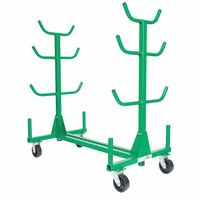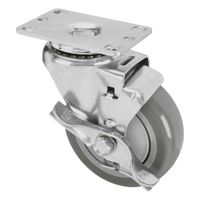Call +(254) 703 030 000 / 751 483 999 / 721 704 777
- Home
- Material Handling
- Transporting
- Carts Trucks
- Panel Bar Pipe Bucket Trucks
.....Read More
Frequently Asked Questions
What are panel trucks used for?
Panel trucks are versatile vehicles primarily used for transporting goods and equipment. They are enclosed, box-shaped trucks without rear windows, providing security and protection for the cargo. Businesses often utilize panel trucks for delivery services, as they can efficiently transport a variety of items, from small packages to larger goods. Their enclosed design makes them ideal for transporting sensitive or valuable items that require protection from weather conditions and theft.
In addition to commercial deliveries, panel trucks are popular among tradespeople such as electricians, plumbers, and carpenters. These professionals use panel trucks to carry tools, equipment, and materials to job sites. The spacious interior allows for organized storage, making it easier to access tools and supplies when needed.
Panel trucks are also used in the moving industry, where they serve as an alternative to larger moving vans for smaller-scale relocations. They are suitable for transporting furniture, appliances, and personal belongings over short to medium distances.
In the realm of advertising, panel trucks can be transformed into mobile billboards. Companies often wrap these vehicles with promotional graphics to increase brand visibility while on the road.
Furthermore, panel trucks are sometimes converted into specialized vehicles, such as mobile workshops, food trucks, or mobile service units. Their adaptability makes them a popular choice for businesses that require a mobile base of operations.
Overall, panel trucks are valued for their practicality, security, and adaptability, making them a staple in various industries for transporting goods and equipment efficiently.
How do bar and pipe trucks prevent items from rolling off?
Bar and pipe trucks prevent items from rolling off through several design features:
1. **Side Rails or Retaining Walls**: These are vertical structures on the sides of the truck bed that act as barriers, preventing cylindrical items like pipes and bars from rolling off the sides during transport.
2. **Cradles or V-Shaped Supports**: The truck bed may have cradles or V-shaped supports that hold the items in place. These supports are designed to fit the curvature of pipes and bars, providing stability and preventing lateral movement.
3. **Tie-Down Straps or Chains**: These are used to secure the load tightly to the truck bed. The straps or chains are fastened over the items and anchored to the truck, ensuring that the load remains stationary even during sudden stops or turns.
4. **Non-Slip Surfaces**: The truck bed may be equipped with non-slip surfaces or coatings that increase friction between the load and the bed, reducing the likelihood of rolling.
5. **End Stops or Bulkheads**: These are barriers at the front and rear of the truck bed that prevent items from rolling forward or backward. They are particularly useful during acceleration or deceleration.
6. **Adjustable Racks**: Some trucks have adjustable racks that can be configured to fit different sizes and quantities of pipes or bars, providing a custom fit that enhances stability.
7. **Load Distribution**: Proper load distribution is crucial. By evenly distributing the weight across the truck bed, the risk of rolling is minimized. This involves strategic placement of items to maintain balance.
These features work together to ensure the safe and secure transport of cylindrical items, minimizing the risk of accidents and damage.
What materials can be transported using bucket trucks?
Bucket trucks, also known as cherry pickers or aerial work platforms, are versatile vehicles used for lifting workers and materials to elevated work sites. They can transport a variety of materials, including:
1. **Electrical Equipment**: Bucket trucks are commonly used by utility companies to transport and install electrical components such as transformers, insulators, and wiring for power lines.
2. **Telecommunications Gear**: These trucks are used to carry and install telecommunications equipment like cables, antennas, and satellite dishes for phone and internet services.
3. **Construction Materials**: In construction, bucket trucks can transport materials like roofing shingles, siding, and other building supplies to elevated areas.
4. **Signage and Lighting**: They are used to install and maintain signs, billboards, and streetlights, transporting materials like metal frames, light fixtures, and bulbs.
5. **Tree Care Equipment**: Arborists use bucket trucks to transport tools and materials for tree trimming and removal, including chainsaws, ropes, and safety gear.
6. **Painting Supplies**: For painting tall structures, bucket trucks can carry paint, brushes, rollers, and other necessary equipment.
7. **Window Cleaning Tools**: In high-rise window cleaning, bucket trucks transport cleaning solutions, squeegees, and other cleaning tools.
8. **Event Equipment**: For setting up events, they can transport lighting rigs, sound equipment, and decorations to elevated positions.
9. **Rescue Operations**: In emergencies, bucket trucks can transport rescue personnel and equipment to reach people in high or difficult-to-access areas.
10. **Maintenance Tools**: For maintenance of tall structures, they carry tools and materials needed for repairs and upkeep.
Bucket trucks are equipped with secure platforms and lifting mechanisms to safely transport these materials to required heights, ensuring efficiency and safety in various industries.
Where are panel, bar, pipe, and bucket trucks commonly used?
Panel trucks are commonly used in urban and suburban areas for the delivery of goods, especially for businesses that require transportation of tools, equipment, or merchandise. They are favored by tradespeople, such as electricians and plumbers, due to their enclosed cargo space which protects contents from weather and theft.
Bar trucks, often referred to as beverage trucks, are primarily used in the beverage distribution industry. They are commonly seen in cities and towns delivering drinks to restaurants, bars, and retail outlets. Their design allows for easy loading and unloading of beverage crates and kegs.
Pipe trucks are specialized vehicles used in industries that require the transportation of long materials, such as pipes, poles, or lumber. They are commonly used in construction, plumbing, and utility sectors. These trucks are often seen on highways and at construction sites, transporting materials to and from job locations.
Bucket trucks, also known as cherry pickers, are widely used in industries that require work at height. They are commonly used by utility companies for maintenance of electrical lines, by telecommunications companies for installing and repairing phone lines, and by municipalities for streetlight maintenance. Additionally, they are used in tree care services for trimming and removing trees, as well as in construction for tasks that require elevated access.
Each of these trucks serves a specific purpose and is designed to meet the needs of particular industries, making them essential tools in their respective fields.
What features do panel trucks have to support panels or sheets?
Panel trucks are designed to transport large, flat items like panels or sheets efficiently and safely. Key features include:
1. **Flatbed or Enclosed Cargo Area**: Provides a stable, flat surface for laying panels or sheets, minimizing movement during transit.
2. **Tie-Down Points**: Equipped with multiple tie-down points or anchor systems to secure the load, preventing shifting or damage.
3. **Side and Rear Access**: Large, often sliding or swing-out doors allow easy loading and unloading of panels, accommodating their size and shape.
4. **Reinforced Flooring**: Durable flooring materials, such as metal or heavy-duty wood, support the weight of heavy panels and resist wear and tear.
5. **Adjustable Shelving or Racks**: Some models include adjustable shelving or racks to organize and separate different types of panels or sheets.
6. **Protective Padding or Liners**: Interior walls may have padding or liners to protect panels from scratches or dents during transport.
7. **Height and Width**: Designed with sufficient height and width to accommodate standard panel sizes, ensuring they fit comfortably without the need for tilting or angling.
8. **Load Capacity**: Engineered to handle the weight of multiple panels, with suspension systems that maintain stability and ride quality.
9. **Non-Slip Surfaces**: Floors may have non-slip surfaces to prevent panels from sliding during transit.
10. **Partition Walls**: Some trucks have partition walls to separate the driver’s cabin from the cargo area, enhancing safety and security.
11. **Lighting**: Interior lighting helps in loading and unloading, especially in low-light conditions.
These features collectively ensure that panel trucks can transport panels or sheets efficiently, safely, and without damage.
How do bucket trucks minimize lifting effort?
Bucket trucks minimize lifting effort through several key mechanisms:
1. **Hydraulic Systems**: These trucks use hydraulic systems to power the boom lift. Hydraulic pumps convert mechanical energy into hydraulic energy, allowing for smooth and controlled lifting and lowering of the bucket. This system requires minimal manual effort from the operator.
2. **Articulating and Telescopic Booms**: Bucket trucks are equipped with either articulating or telescopic booms, or a combination of both. Articulating booms have multiple joints that allow for flexible movement around obstacles, while telescopic booms extend linearly to reach higher elevations. These designs enable precise positioning with minimal effort.
3. **Stabilizers and Outriggers**: To ensure safety and stability during operation, bucket trucks are equipped with stabilizers or outriggers. These extend from the truck to provide a wider base, reducing the risk of tipping and allowing the boom to lift heavier loads with less effort.
4. **Ergonomic Controls**: Modern bucket trucks feature ergonomic control systems that allow operators to maneuver the boom and bucket with ease. Joysticks and control panels are designed for intuitive use, reducing physical strain on the operator.
5. **Load Sensing Technology**: Some bucket trucks are equipped with load sensing technology that automatically adjusts the hydraulic pressure based on the weight of the load. This ensures efficient use of energy and minimizes the effort required to lift varying weights.
6. **Electric and Hybrid Models**: Advances in technology have led to the development of electric and hybrid bucket trucks, which offer quieter operation and reduced emissions. These models often feature advanced energy management systems that optimize power usage, further minimizing lifting effort.
By integrating these technologies, bucket trucks efficiently reduce the physical and mechanical effort required for lifting operations.
What types of materials are typically transported with bar and pipe trucks?
Bar and pipe trucks are specialized vehicles designed to transport long, cylindrical, or elongated materials. The types of materials typically transported with these trucks include:
1. **Steel Pipes and Tubes**: Used in construction, plumbing, and oil and gas industries, these are among the most common materials transported.
2. **PVC and Plastic Pipes**: Lightweight and used for plumbing, drainage, and irrigation systems.
3. **Copper Pipes**: Essential for plumbing and HVAC systems due to their durability and thermal conductivity.
4. **Aluminum Pipes and Tubes**: Used in construction and manufacturing for their lightweight and corrosion-resistant properties.
5. **Rebar**: Steel reinforcing bars used to strengthen concrete structures in construction projects.
6. **Structural Steel Beams**: Including I-beams, H-beams, and other profiles used in building frameworks and infrastructure projects.
7. **Timber and Lumber**: Long wooden beams and planks used in construction and carpentry.
8. **Conduit Pipes**: Used to protect and route electrical wiring in buildings and infrastructure.
9. **Plastic and Composite Bars**: Used in various industrial applications for their lightweight and corrosion-resistant properties.
10. **Fiberglass Pipes**: Used in industries requiring corrosion-resistant piping solutions.
11. **Galvanized Pipes**: Steel pipes coated with zinc for corrosion resistance, used in outdoor and industrial applications.
12. **Concrete Pipes**: Used in large-scale drainage and sewage systems.
13. **Drill Pipes**: Used in the oil and gas industry for drilling operations.
14. **Rail Tracks**: Steel rails used in railway construction and maintenance.
These materials are typically long and require secure handling and transportation, making bar and pipe trucks ideal due to their design, which accommodates the length and weight of such items.



